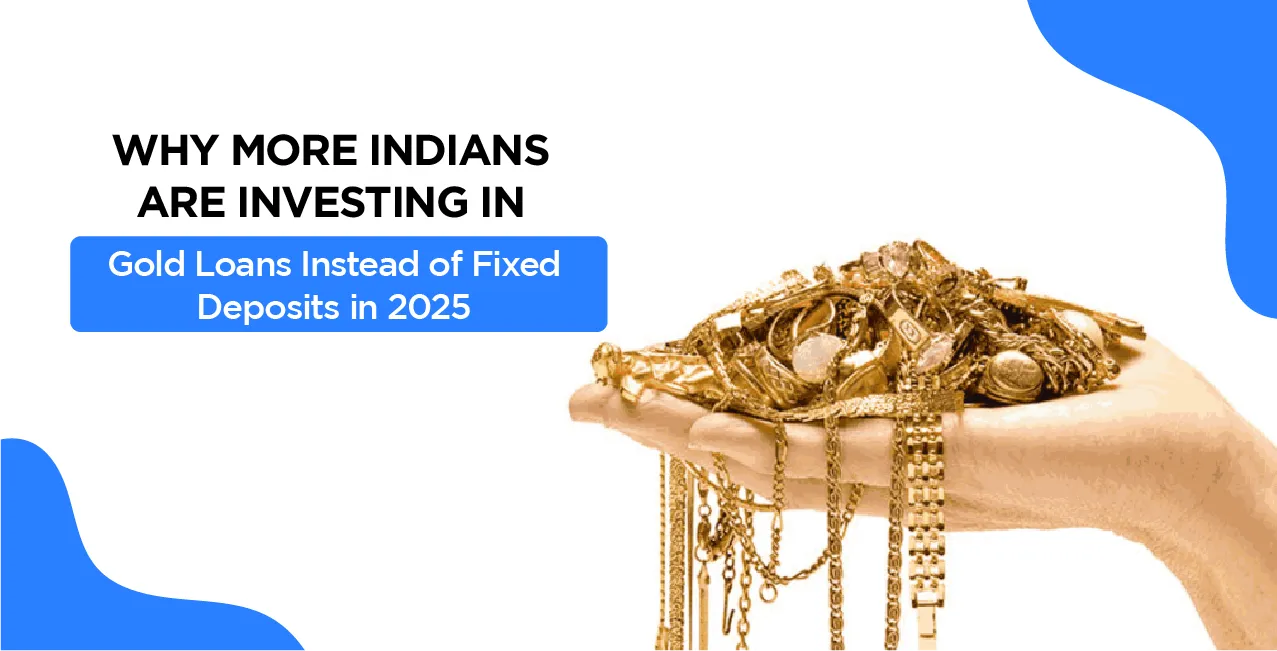
Author
LoansJagat Team
Read Time
9 Minute
18 Mar 2025
Why More Indians Are Choosing Gold Loans Over Fixed Deposits in 2025
In Kerala, Anjali, a schoolteacher, faced unexpected medical expenses. With her savings tied up in a fixed deposit (FD) that offered a modest 6% annual interest, accessing funds quickly was challenging.
She considered liquidating her FD but was confused by early withdrawal penalties and the loss of accrued interest.
In contrast, her neighbour, Ravi, had invested in a gold loan, which allowed him to access funds swiftly by pledging his gold jewellery. This flexibility and quick access to funds has led many Indians, like Anjali, to reconsider their investment choices.
In 2024, a report revealed that 62% of Indians preferred mutual funds and Systematic Investment Plans (SIPs) over traditional FDs, highlighting a shift towards more investment avenues.
The performance of gold loan providers further supports this trend. Muthoot Finance, a leading gold loan company, reported a 33% increase in its third-quarter profit, reaching ₹13.63 billion, driven by strong demand for gold loans.
These developments suggest a growing preference among Indians for investments that offer higher returns and greater liquidity, such as gold loans, over traditional fixed deposits.
How Gold Loans Are Overtaking Fixed Deposits in 2025
In 2025, more Indians will turn to gold loans rather than traditional fixed deposits (FDs) to meet their financial needs.
This shift is primarily driven by two factors:
- Higher liquidity and
- Lower interest rates compared to unsecured loans.
Higher Liquidity Compared to Fixed Deposits
One main reason people choose gold loans over fixed deposits is the higher liquidity they offer.
Liquidity means how quickly you can access your money when you need it. Fixed deposits are long-term investments that lock in your money for a set period. While they earn interest, you cannot access the funds before maturity without facing penalties.
Read More – How to Invest in Gold: A Complete Guide for Indian Investors
On the other hand, gold loans provide quick access to funds without such penalties.
For example, consider a person who needs urgent cash for medical treatment. If they have a fixed deposit, they might have to wait a few days to withdraw the money, and the bank could charge a penalty for early withdrawal.
In contrast, a gold loan is typically approved within 30 minutes, and you get immediate access to the funds.
Let’s say you want a loan of ₹10 lakh. With a gold loan, this amount can be disbursed quickly, whereas, for an FD, you will need to go through a lengthy process of breaking the FD and paying penalties. This quick process makes gold loans the preferred choice for many.
Here’s a simple comparison between the liquidity of an FD and a gold loan:
Feature | Fixed Deposit | Gold Loan |
Approval Time | 1-7 days | 30 minutes to 1 hour |
Penalty for Early Withdrawal | Yes, 1-2% | No penalty |
Amount Access | Only after maturity | Immediate access |
Lower Interest Rates Compared to Unsecured Loans
Another significant advantage of gold loans is their lower interest rates than unsecured loans, such as personal loans. When you apply for a personal loan, the interest rate can range from 12% to 25%, depending on your credit score and the lender.
However, gold loans offer a much lower interest rate, typically around 10% to 12%. This makes gold loans an attractive option for people who need funds but want to avoid the high interest burden of unsecured loans.
For instance, if you take a personal loan of ₹10 lakh, the interest rate could be 20%. Over 5 years, you would pay approximately ₹4 lakh as interest.
But with a gold loan, at an interest rate of 10%, you would only pay ₹1 lakh as interest for the same amount and period.
Here’s a quick example showing the difference in interest rates:
Loan Type | Loan Amount | Interest Rate | Interest for 5 Years | Total Payable Amount |
Personal Loan | ₹10 lakh | 20% | ₹4 lakh | ₹14 lakh |
Gold Loan | ₹10 lakh | 10% | ₹1 lakh | ₹11 lakh |
As you can see, the difference in interest can be significant. For a ₹10 lakh loan, you could save ₹3 lakh by choosing a gold loan over a personal loan.
The Rise of Gold Loans
Let’s take the case of Sanjay, a small business owner from Mumbai. He has a turnover of ₹1.5 crore per year and needed an urgent loan of ₹15 lakh to expand his business.
He considered both options: a fixed-deposit loan and a gold loan. His fixed-deposit loan offered him a loan against the FD, but the interest rate was 7%, and he would need to wait a week to get the money.
In contrast, he opted for a gold loan, where he could pledge his gold jewellery and get ₹15 lakh within an hour. The interest rate for the gold loan was 11%, but he could manage this because of the quick access to funds. This flexibility and ease of access helped him make a critical decision for his business expansion.
Similarly, Anita, a schoolteacher from Bangalore, needed a personal loan to consolidate her debts. She had an income of ₹50,000 and needed ₹5 lakh to pay off her outstanding loans.
She initially thought about a personal loan but was discouraged by the high interest rate of 22%. Instead, she decided to pledge her gold jewellery and took a gold loan for ₹5 lakh at an interest rate of 11%. This helped her reduce her financial burden and pay off her debts at a much lower cost.
Comparing Average Loan Amounts and Income Levels
Gold loans are also preferred by individuals with relatively higher incomes or business owners with significant turnover.
Here’s a look at some typical loan amounts and income levels that are leading people to choose gold loans:
Loan Type | Average Loan Amount | Average Monthly Income |
Personal Loan | ₹10 lakh to ₹20 lakh | ₹50,000 |
Debt Consolidation Loan | ₹15 lakh to ₹30 lakh | ₹80,000 |
Overdraft Loan | ₹10 lakh to ₹20 lakh | ₹75,000 |
Business Loan (BL) | ₹10 lakh to ₹20 lakh | ₹1 crore to ₹2 crore (Turnover) |
Home Loan | ₹50 lakh to ₹1 crore | ₹75,000 to ₹1.5 lakh |
As shown in the table, business owners or individuals with higher incomes tend to prefer larger loan amounts that can be accessed quickly through gold loans.
These loans give them flexibility and quick cash flow without the lengthy processes associated with traditional loans or FDs.
No Prepayment Penalties
One of the standout benefits of gold loans is the absence of prepayment penalties. In contrast to personal loans or fixed deposits, where you may be penalised for repaying the loan early or breaking your FD before maturity, gold loans offer complete flexibility.
If you are in a situation where you can repay the loan early, you can do so without any extra cost or penalty. This is a huge benefit for borrowers who want to clear their debt sooner rather than waiting for the entire term to end.
Example:
Suppose you take a gold loan of ₹15 lakh at 12% interest for 3 years. If you repay the loan early, after 18 months, there will be no penalty or extra charges.
In contrast, for a fixed deposit, if you choose to withdraw your FD before its maturity, you may lose up to 2% of the interest you’ve earned.
Here’s a simple comparison between gold loans and fixed deposits regarding prepayment penalties:
Loan Type | Prepayment Penalty |
Gold Loan | None |
Fixed Deposit | 1-2% of the earned interest |
Flexible Repayment Options
- Gold loans offer various repayment methods, making it easier to manage cash flow.
- EMI (Equated Monthly Installments): Pay the loan equally monthly.
- Bullet Repayment: Pay the full loan amount at the end of the term.
- Interest-Only Repayment: Pay only the interest monthly and clear the principal at the end.
Example:
Asha, a small business owner with a turnover of ₹1.2 crore, takes a gold loan of ₹20 lakh at a 10% interest rate.
- She opts to pay just ₹20,000 monthly interest.
- At the end of the term, she repays the entire ₹20 lakh principal.
- This option helps Asha keep her business running without worrying about monthly principal payments.
Why Gold Loans Are Better:
- Unlike fixed deposits, gold loans give you flexibility without locking your money for a long time.
- Breaking an FD early results in penalties and loss of interest, which makes it less flexible.
Gold Loans Do Not Impact Your Savings
- Gold loans only require you to pledge your gold while your savings remain untouched.
- Fixed deposits (FDs) lock your money for a set period. If you break the FD early, you lose interest and get a reduced amount.
Example:
Rohit earns ₹50,000 a month and has ₹5 lakh in savings.
- He needs ₹3 lakh urgently for his daughter’s education.
- Instead of breaking his FD and paying penalties, he pledges his gold jewellery and gets a ₹3 lakh loan.
- His savings remain untouched, and he continues to earn interest on them.
Why Gold Loans Are Better:
- With gold loans, you don’t need to touch your savings.
- Breaking an FD early could lead to lost interest and hurt your future financial goals.
Quick and Hassle-Free Processing
Gold loans are one of the quickest loan options available. Getting a gold loan is fast and easy, typically taking 30 minutes to a few hours.
Unlike personal loans or home loans, which require extensive documentation and can take weeks to approve, gold loans have minimal documentation requirements.
Most banks and non-banking financial companies (NBFCs) require just a few essential documents, like ID proof, address proof, and the gold you wish to pledge.
Also Read – Why Banks Are Offering Higher FD Interest Rates in 2025
Example:
Ravi, a business owner with a turnover of ₹1.5 crore, needs ₹15 lakh for urgent business expansion. He approaches a bank and pledges his gold jewellery. Within an hour, Ravi has ₹15 lakh to continue his business growth. He does not have to wait for days or weeks, as would be the case with a personal loan, which requires credit score checks and approval processes that take much longer.
In contrast, a fixed deposit or other loans could require longer waiting times and extensive paperwork, making them less ideal when urgent funds are needed.
Conclusion
The shift from fixed deposits to gold loans is gaining momentum due to their higher liquidity, lower interest rates than unsecured loans, and quicker approval times.
With these advantages, gold loans are an attractive alternative for people needing immediate financial support. Whether for personal needs, business expansion, or debt consolidation, gold loans are becoming an essential economic tool in 2025.
FAQs
Why are more Indians choosing gold loans over fixed deposits?
Gold loans offer quick access to money, lower interest rates, and no penalties for early repayment, unlike fixed deposits.
Are gold loans cheaper than personal loans?
Yes, gold loans usually have lower interest rates (around 10-12%) compared to personal loans (12-25%).
Can I repay a gold loan early without extra charges?
Yes, gold loans have no prepayment penalties, so you can repay anytime without extra cost.
What documents are needed for a gold loan?
You usually need ID proof, address proof, and the gold you want to pledge—no lengthy paperwork required.
Other Related Pages | |||
Why More Indians Are Choosing Gold Loans Over Fixed Deposits in 2025 | |||
About the Author

LoansJagat Team
‘Simplify Finance for Everyone.’ This is the common goal of our team, as we try to explain any topic with relatable examples. From personal to business finance, managing EMIs to becoming debt-free, we do extensive research on each and every parameter, so you don’t have to. Scroll up and have a look at what 15+ years of experience in the BFSI sector looks like.

Quick Apply Loan
Subscribe Now
Related Blog Post


